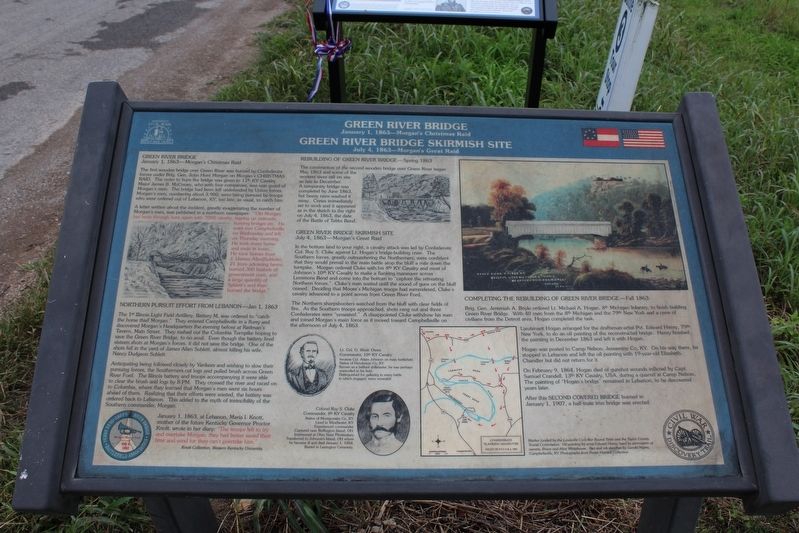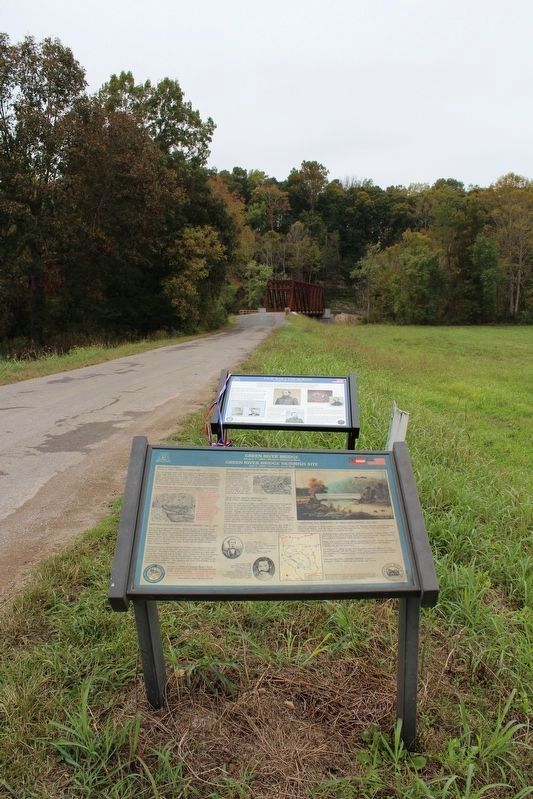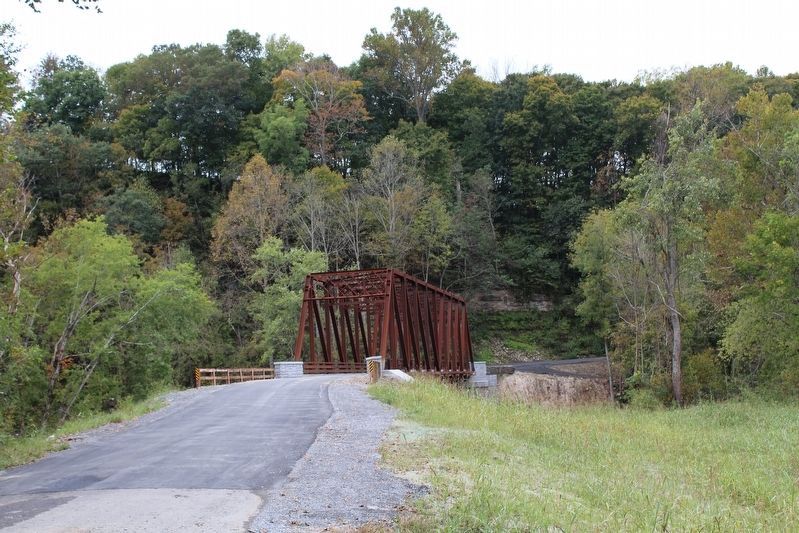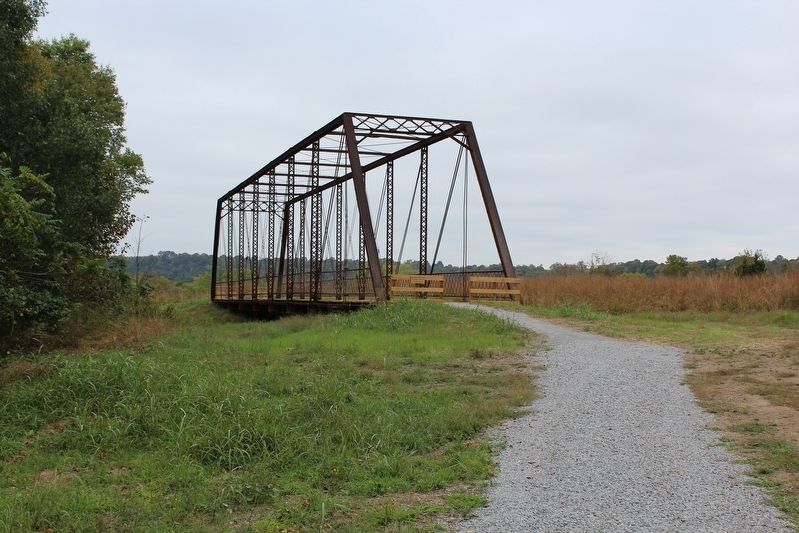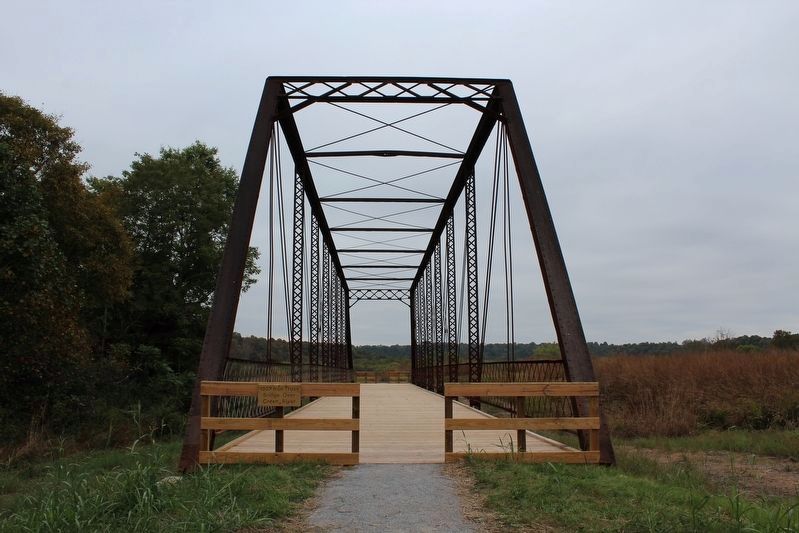Near Campbellsville in Taylor County, Kentucky — The American South (East South Central)
Green River Bridge / Green River Bridge Skirmish Site
January 1, 1863—Morgan's Christmas Raid / July 4, 1863—Morgan's Great Raid
January 1, 1863—Morgan's Christmas Raid
The first wooden bridge over Green River was burned by Confederate forces under Brig. Gen. John Hunt Morgan on Morgan's Christmas Raid. The order to burn the bridge was given to 11th KY Cavalry Major James B. McCreary, who with four companies, was rear guard of Morgan's men. The bridge had been left undefended by Union forces. Morgan's men, numbering about 3,900, were being pursued by troops who were ordered out of Lebanon, KY, too late, as usual, to catch him.
A letter written about the incident, greatly exaggerating the number of Morgan's men, was published in a northern newspaper: "Old Morgan has been through here again with 7000 cavalry, tearing up railroads, burning bridges, etc. He went into Campbellsville on Wednesday and left on Thursday morning. He took every horse and mule in town...He took horses from J. (James Allen) Sublette, 21 from adjoining farms, burned 300 bushels of government corn, and a large quantity of Sublett's and then burned the bridge."
Northern Pursuit Effort from Lebanon—Jan 1, 1863
The 1st Illinois Light Field Artillery, Battery M, was ordered to "catch the horse thief Morgan." They entered Campbellsville in a flurry and discovered Morgan's Headquarters the evening before at Redman's Tavern, Main Street. They rushed out the Columbia Turnpike hoping to save the Green River Bridge, to no avail. Even though the battery fired sixteen shots at Morgan's forces, it did not save the bridge. One of the shots fell in the yard of James Allen Sublett, almost killing his wife, Nancy Dudgeon Sublett.
Anticipating being followed closely by Yankees and wishing to slow their pursuing forces, the Southerners cut logs and pulled brush across Green River Ford. The Illinois battery and troops accompanying it were able to clear the brush and logs by 8 PM. They crossed the river and raced on to Columbia, where they learned that Morgan's men were six hours ahead of them. Realizing that their efforts were wasted, the battery was ordered back to Lebanon. This added to the myth of invincibility of the Southern commander, Morgan.
January 1, 1863, at Lebanon, Maria I. Knott, mother of the future Kentucky Governor Proctor Knott, wrote in her diary: "The troops left to try and overtake Morgan, they had better saved their time and wind for they can't overtake him."
Knott Collection, Western Kentucky University
Rebuilding of Green River Bridge—Spring 1863
The construction of the second wooden bridge over Green River began May 1863 and some of the workers were still on site as late as December. A temporary bridge was completed by June 1863, but heavy rains washed it away. Crews immediately set to work and it appeared as in the sketch to the right on July 4, 1863, the date of the Battle of Tebbs Bend.
Green River Bridge Skirmish Site
July 4, 1863—Morgan's Great Raid
In the bottom land to your right, a cavalry attack was led by Confederate Col. Roy S. Cluke against Lt. Hogan's bridge building crew. The Southern forces, greatly outnumbering the Northerners, were confident that they would prevail in the main battle atop the bluff a mile down the turnpike. Morgan ordered Cluke with his 8th KY Cavalry and most of Johnson's 10th KY Cavalry to make a flanking maneuver across Lemmons Bend and come in to the bottom to "capture the retreating Northern forces." Cluke's men waited until the sound of guns on the bluff ceased. Deciding that Moore's Michigan troops had surrendered, Cluke's cavalry advanced to a point across from Green River Ford.
The Northern sharpshooters watched from the bluff with clear fields of fire. As the Southern troops approached, shots rang out and three Confederates were "unseated." A disappointed Cluke withdrew his men and joined Morgan's main force as it moved towards Campbellsville on the afternoon of July 4, 1863,
Completing the Rebuilding of Green River Bridge—Fall 1863
Brig. Gen. Jeremiah A. Boyle ordered Lt. Michael A. Hogan, 8th Michigan Infantry, to finish building Green River Bridge. With 40 men from the 8th Michigan and the 79th New York and a crew of civilians from the Detroit area, Hogan completed the task.
Lieutenant Hogan arranged for the draftsmen-artist Pvt. Edward Henry, 79th New York, to do an oil painting of the reconstructed bridge. Henry finished the painting in December 1863 and left it with Hogan.
Hogan was posted to Camp Nelson, Jessamine Co, KY. On his way there, he stopped in Lebanon and left the oil painting with 19-year-old Elizabeth Chandler but did not return for it.
On February 9, 1864, Hogan died of gunshot wounds inflicted by Capt. Samuel Crandell, 13th Ky Cavalry, USA, during a quarrel at Camp Nelson. The painting of "Hogan's bridge" remained in Lebanon, to be discovered years later.
After this Second Covered Bridge burned in January 1, 1907, a half-truss iron bridge was erected.
(captions)
Lt. Col. G. Wash Owen
Commander, 10th KY Cavalry
because Col. Adam Johnson on main battlefield. Native of Henderson Co., KY. Known as a brilliant drillmaster, he was perhaps unexcelled in his field. Distinguished for gallantry in every battle in which engaged; twice wounded.
Colonel Roy S. Cluke
Commander, 8th KY Cavalry
Native of Montgomery Co., KY. Lived in Winchester, KY. Experienced commander. Captured near Buffington Island, OH. Imprisoned at Ohio State Penitentiary. Transferred to Johnson's Island, OH where he became ill and died January 1, 1864. Buried in Lexington Cemetery.
Erected by Kentucky Heartland Civil War Trails Commission.
Topics and series. This historical marker is listed in these topic lists: Bridges & Viaducts • War, US Civil. In addition, it is included in the John Hunt Morgan Heritage Trail in Kentucky series list. A significant historical date for this entry is July 4, 1863.
Location. 37° 14.781′ N, 85° 21.784′ W. Marker is near Campbellsville, Kentucky, in Taylor County. Marker is on Tebbs Bend Road, 0.6 miles New Columbia Road (Kentucky Route 55), on the right when traveling south. Touch for map. Marker is in this post office area: Campbellsville KY 42718, United States of America. Touch for directions.
Other nearby markers. At least 8 other markers are within walking distance of this marker. Civil War Camp Hobson (here, next to this marker); Federal Stockade (approx. 0.2 miles away); Federal Hospital (approx. 0.2 miles away); Federal Field Hospital (approx. ¼ mile away); Camp Site (approx. 0.3 miles away); Battle of Green River Bridge (approx. ¾ mile away); "No Day to Surrender" (approx. 0.8 miles away); Morgan's Demand for Surrender (approx. one mile away). Touch for a list and map of all markers in Campbellsville.
Also see . . . Tebbs Bend-Green River Bridge Battlefield Association. (Submitted on October 31, 2016.)
Credits. This page was last revised on May 20, 2019. It was originally submitted on October 25, 2016, by Tom Bosse of Jefferson City, Tennessee. This page has been viewed 798 times since then and 31 times this year. Last updated on May 17, 2019, by Bradley Owen of Morgantown, West Virginia. Photos: 1, 2, 3, 4, 5. submitted on October 25, 2016, by Tom Bosse of Jefferson City, Tennessee. • Andrew Ruppenstein was the editor who published this page.
